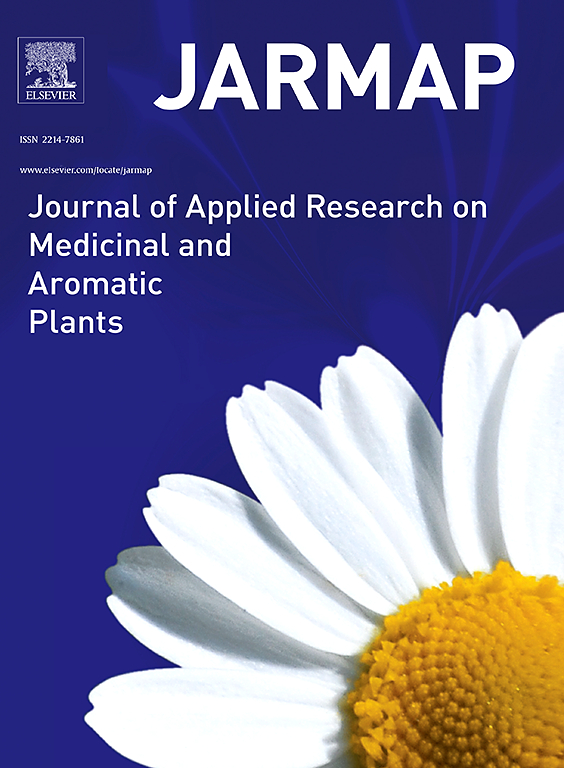姜源外泌体样纳米颗粒分离的优化:聚乙二醇、过滤和pH的协同效应
IF 3.6
2区 农林科学
Q1 PLANT SCIENCES
Journal of Applied Research on Medicinal and Aromatic Plants
Pub Date : 2025-07-29
DOI:10.1016/j.jarmap.2025.100649
引用次数: 0
摘要
植物源性外泌体样纳米颗粒(PELNPs)是一种很有前途的生物活性药物,姜源性外泌体样纳米颗粒(GELNPs)因其抗炎、抗氧化和神经保护特性而表现出显著的治疗潜力。虽然聚乙二醇(PEG)为PELNP分离提供了一种具有成本效益的超离心替代方法,但需要改进方法以提高产量、稳定性和可重复性。本研究在现有生姜纳米囊泡方案的基础上,通过整合PEG6000沉淀、pH调节和0.45 µm过滤,系统地优化了GELNP分离。我们提出了pH调制与过滤的第一个比较评估,展示了不同的权衡:pH调节的GELNPs实现了更小的尺寸,而过滤的GELNPs表现出更好的胶体稳定性和更低的多分散性指数(PDI)。此外,我们确定了先前未报道的GELNP性质的季节性变化,与其他月份分离的纳米颗粒相比,7月份衍生的纳米颗粒表现出更高的稳定性和更小的尺寸。综合的物理化学表征-包括透射电子显微镜(TEM),原子力显微镜(AFM),粒度分析(PSA), zeta电位分析和傅里叶变换红外光谱(FT-IR) -证实了形态,尺寸分布,表面电荷和生物分子组成的差异。这些发现强调了季节性调整、优化分离方案的必要性,以确保批次间的一致性和最大限度地提高治疗效果,特别是在药物输送应用方面。通过解决关键的方法差距和引入时间考虑,这项工作建立了一个可扩展的、高质量的GELNP生产框架。本文章由计算机程序翻译,如有差异,请以英文原文为准。
Optimization of ginger-derived exosome-like nanoparticle isolation: Synergistic effects of polyethylene glycol, filtration, and pH
Plant-derived exosome-like nanoparticles (PELNPs) represent promising bioactive agents, with ginger-derived exosome-like nanoparticles (GELNPs) exhibiting notable therapeutic potential due to their anti-inflammatory, antioxidant, and neuroprotective properties. While polyethylene glycol (PEG)-based extraction offers a cost-effective alternative to ultracentrifugation for PELNP isolation, methodological refinements are needed to enhance yield, stability, and reproducibility. This study systematically optimizes GELNP isolation by integrating PEG6000 precipitation with pH adjustment and 0.45 µm filtration, building upon existing ginger nanovesicle protocols. We present the first comparative evaluation of pH modulation versus filtration, demonstrating distinct trade-offs: pH-adjusted GELNPs achieved smaller size, whereas filtered GELNPs exhibited superior colloidal stability and lower polydispersity index (PDI). Furthermore, we identify previously unreported seasonal variations in GELNP properties, with July-derived nanoparticles displaying enhanced stability and reduced size compared to those isolated in other months. Comprehensive physicochemical characterization—including transmission electron microscopy (TEM), atomic force microscopy (AFM), particle size analysis (PSA), zeta potential analysis, and Fourier-transform infrared spectroscopy (FT-IR)—confirmed differences in morphology, size distribution, surface charge, and biomolecular composition. These findings highlight the necessity for seasonally adjusted, optimized isolation protocols to ensure batch-to-batch consistency and maximize therapeutic efficacy, particularly for drug delivery applications. By addressing critical methodological gaps and introducing temporal considerations, this work establishes a framework for scalable, high-quality GELNP production.
求助全文
通过发布文献求助,成功后即可免费获取论文全文。
去求助
来源期刊

Journal of Applied Research on Medicinal and Aromatic Plants
Pharmacology, Toxicology and Pharmaceutics-Drug Discovery
CiteScore
6.40
自引率
7.70%
发文量
80
审稿时长
41 days
期刊介绍:
JARMAP is a peer reviewed and multidisciplinary communication platform, covering all aspects of the raw material supply chain of medicinal and aromatic plants. JARMAP aims to improve production of tailor made commodities by addressing the various requirements of manufacturers of herbal medicines, herbal teas, seasoning herbs, food and feed supplements and cosmetics. JARMAP covers research on genetic resources, breeding, wild-collection, domestication, propagation, cultivation, phytopathology and plant protection, mechanization, conservation, processing, quality assurance, analytics and economics. JARMAP publishes reviews, original research articles and short communications related to research.
 求助内容:
求助内容: 应助结果提醒方式:
应助结果提醒方式:


